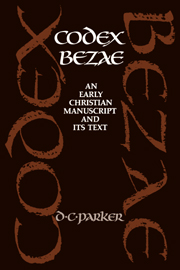Book contents
- Front Matter
- Contents
- List of illustrations
- Preface
- Abbreviations and textual conventions
- Introduction
- PART I The palaeography
- PART II The scribe and the tradition
- PART III The correctors
- Chapter Nine The corrections
- Chapter Ten The supplementary leaves
- Chapter Eleven The development of the corrected text
- PART IV The bilingual tradition
- Part V Text and codex
- Appendices
- Plates
- Notes on the plates
- Indexes
Chapter Ten - The supplementary leaves
Published online by Cambridge University Press: 09 November 2009
- Front Matter
- Contents
- List of illustrations
- Preface
- Abbreviations and textual conventions
- Introduction
- PART I The palaeography
- PART II The scribe and the tradition
- PART III The correctors
- Chapter Nine The corrections
- Chapter Ten The supplementary leaves
- Chapter Eleven The development of the corrected text
- PART IV The bilingual tradition
- Part V Text and codex
- Appendices
- Plates
- Notes on the plates
- Indexes
Summary
The extensive correction of the text comes to an end in the seventh century. One corrector may have touched the manuscript after its removal to Lyons.
By the ninth century, the manuscript had become incomplete, some gatherings being altogether lost. The long gap between Ff348 and 415 had already been formed. The school of Florus made no attempt to replace the whole of this lacuna. Only the final verses of Mark were supplied (this is certain because, although the end of 3 John appears on F415, αρχεται πραξις αποστολων is written on the opposite page, 348b*). Also added were a leaf in Matthew 3, and the middle of John 18 to the beginning of chapter 20 (see chapter 3 for details). It is actually in this late period that we find the bilingual character of the manuscript being taken seriously, for the first time since its youth.
Another manuscript that had missing portions supplied at Lyons is described by Tafel (Part IV, p. 49). It is Lyons Ms 443 (372), of Origen on the Heptateuch, made up out of a half-uncial and an uncial manuscript, with portions still missing supplied in Visigothic minuscule. Besides the programme of conservation referred to in chapter 3, we may note that the practice of rewriting illegible parts of manuscripts, which is quite common in D, is also paralleled in Tafel's research by Mss 2 (Lyons 604) and 18 (Paris Lat. 9550) in his list.
- Type
- Chapter
- Information
- Codex BezaeAn Early Christian Manuscript and its Text, pp. 166 - 174Publisher: Cambridge University PressPrint publication year: 1992

